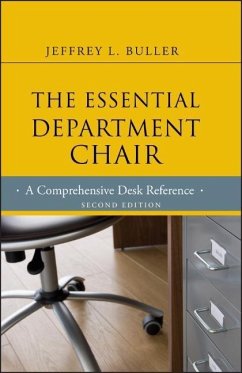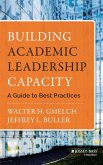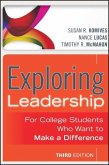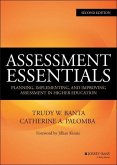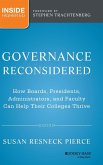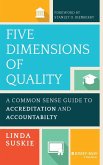- Gebundenes Buch
- Merkliste
- Auf die Merkliste
- Bewerten Bewerten
- Teilen
- Produkt teilen
- Produkterinnerung
- Produkterinnerung
Thoroughly revised and updated, this second edition of the classic book The Essential Department Chair is designed to be more comprehensive and up-to-date. The new edition incorporates many timely topics and is now truly more than a guide--it's a much-needed desk reference, a book that includes "everything you need to know to be a department chair." The book contains a wealth of new case studies and shows new department chairs how the guidelines would perform in a real-life situation.
Andere Kunden interessierten sich auch für
![Building Academic Leadership Capacity Building Academic Leadership Capacity]() Walter H. GmelchBuilding Academic Leadership Capacity52,99 €
Walter H. GmelchBuilding Academic Leadership Capacity52,99 €![Advancing Social Justice Advancing Social Justice]() Tracy DavisAdvancing Social Justice52,99 €
Tracy DavisAdvancing Social Justice52,99 €![Teaching Naked Teaching Naked]() José Antonio BowenTeaching Naked27,99 €
José Antonio BowenTeaching Naked27,99 €![Exploring Leadership with Access Code Exploring Leadership with Access Code]() Susan R. KomivesExploring Leadership with Access Code75,99 €
Susan R. KomivesExploring Leadership with Access Code75,99 €![Assessment Essentials Assessment Essentials]() Trudy W. BantaAssessment Essentials58,99 €
Trudy W. BantaAssessment Essentials58,99 €![Governance Reconsidered Governance Reconsidered]() Susan R. PierceGovernance Reconsidered53,99 €
Susan R. PierceGovernance Reconsidered53,99 €![Five Dimensions of Quality Five Dimensions of Quality]() Linda SuskieFive Dimensions of Quality55,99 €
Linda SuskieFive Dimensions of Quality55,99 €-
-
-
Thoroughly revised and updated, this second edition of the classic book The Essential Department Chair is designed to be more comprehensive and up-to-date. The new edition incorporates many timely topics and is now truly more than a guide--it's a much-needed desk reference, a book that includes "everything you need to know to be a department chair." The book contains a wealth of new case studies and shows new department chairs how the guidelines would perform in a real-life situation.
Hinweis: Dieser Artikel kann nur an eine deutsche Lieferadresse ausgeliefert werden.
Hinweis: Dieser Artikel kann nur an eine deutsche Lieferadresse ausgeliefert werden.
Produktdetails
- Produktdetails
- Verlag: Wiley & Sons
- 2. Aufl.
- Seitenzahl: 496
- Erscheinungstermin: 24. Januar 2012
- Englisch
- Abmessung: 236mm x 158mm x 43mm
- Gewicht: 718g
- ISBN-13: 9781118123744
- ISBN-10: 1118123743
- Artikelnr.: 33876312
- Herstellerkennzeichnung
- Libri GmbH
- Europaallee 1
- 36244 Bad Hersfeld
- gpsr@libri.de
- Verlag: Wiley & Sons
- 2. Aufl.
- Seitenzahl: 496
- Erscheinungstermin: 24. Januar 2012
- Englisch
- Abmessung: 236mm x 158mm x 43mm
- Gewicht: 718g
- ISBN-13: 9781118123744
- ISBN-10: 1118123743
- Artikelnr.: 33876312
- Herstellerkennzeichnung
- Libri GmbH
- Europaallee 1
- 36244 Bad Hersfeld
- gpsr@libri.de
THE AUTHOR Jeffrey L. Buller is dean of the Harriet L. Wilkes Honors College at Florida Atlantic University and author of The Essential Academic Dean, The Essential College Professor, and Academic Leadership Day by Day. He is widely known as a consultant, speaker, and writer about nearly every aspect of life as an academic leader.
The Author xi
Introduction xiii
PART ONE The Chair's Role and Career Path
1. In the Trenches 3
2. Preparing for the Chair's Role 14
3. Assessing What Kind of Department Chair You Are 23
4. Serving as an Untenured Department Chair 34
5. Coexisting with a Former Chair 41
6. Creating a Career Plan 49
7. Returning to the Faculty 58
8. Seeking Higher Administrative Positions 66
9. A Scenario Analysis on the Chair's Role and Career Path 75
PART TWO Departmental Management and Politics
10. Understanding Departmental Ethics and Politics 85
11. Chairing Small Departments 92
12. Chairing Large Departments 99
13. Setting Course Rotations and Schedules 108
14. Making Decisions 114
15. Setting Annual Themes 124
16. Creating Departmental Centers for Excellence in Teaching and Learning
132
17. A Scenario Analysis on Departmental Management and Politics 142
PART THREE The Chair's Role in Searches, Hiring, and Firing
18. Writing Job Descriptions and Position Announcements 157
19. Understanding the Chair's Role in the Search Process 168
20. Interviewing Candidates 176
21. Letting Someone Go 188
22. A Scenario Analysis on Hiring and Firing 196
PART FOUR Mentoring Challenges and Opportunities for Department Chairs
23. Helping Faculty Members Sharpen Their Focus 205
24. Coaching Faculty Members to Increase Productivity 211
25. Promoting a More Collegial Department 217
26. Coping with Passive-Aggressive Behavior 224
27. Resolving Chronic Complaints 231
28. Addressing Staff Conflicts 240
29. Overcoming Conflicts 247
30. A Scenario Analysis on Mentoring Challenges 257
PART FIVE The Chair's Role in Faculty Development
31. Facilitating a Positive First-Year Faculty Experience 267
32. Coaching Faculty in Writing Effective Résumés 274
33. Creating an Effective Professional Development Plan 279
34. Creating an Effective Teaching Portfolio 290
35. Creating an Effective Course Syllabus 302
36. Promoting Creativity in Teaching and Learning 309
37. A Scenario Analysis on Faculty Development 317
PART SIX Best Practices in Evaluation and Assessment
38. Creating Written Evaluations 327
39. Conducting Oral Evaluation Sessions 337
40. Writing Letters of Recommendation 343
41. Doing Assessment Effectively 352
42. Conducting Program Reviews 364
43. Conducting Posttenure Reviews 380
44. A Scenario Analysis on Evaluation and Assessment 389
PART SEVEN Essentials of Budgeting and Planning
45. Strategic Planning 401
46. Planning a Budget 411
47. Implementing a Budget 418
48. Fundraising 425
49. Accounting for Sponsored Research 440
50. A Scenario Analysis on Strategic Budgeting and Planning 449
Epilogue: A Checklist for the Essential Department Chair 457
Index 463
Introduction xiii
PART ONE The Chair's Role and Career Path
1. In the Trenches 3
2. Preparing for the Chair's Role 14
3. Assessing What Kind of Department Chair You Are 23
4. Serving as an Untenured Department Chair 34
5. Coexisting with a Former Chair 41
6. Creating a Career Plan 49
7. Returning to the Faculty 58
8. Seeking Higher Administrative Positions 66
9. A Scenario Analysis on the Chair's Role and Career Path 75
PART TWO Departmental Management and Politics
10. Understanding Departmental Ethics and Politics 85
11. Chairing Small Departments 92
12. Chairing Large Departments 99
13. Setting Course Rotations and Schedules 108
14. Making Decisions 114
15. Setting Annual Themes 124
16. Creating Departmental Centers for Excellence in Teaching and Learning
132
17. A Scenario Analysis on Departmental Management and Politics 142
PART THREE The Chair's Role in Searches, Hiring, and Firing
18. Writing Job Descriptions and Position Announcements 157
19. Understanding the Chair's Role in the Search Process 168
20. Interviewing Candidates 176
21. Letting Someone Go 188
22. A Scenario Analysis on Hiring and Firing 196
PART FOUR Mentoring Challenges and Opportunities for Department Chairs
23. Helping Faculty Members Sharpen Their Focus 205
24. Coaching Faculty Members to Increase Productivity 211
25. Promoting a More Collegial Department 217
26. Coping with Passive-Aggressive Behavior 224
27. Resolving Chronic Complaints 231
28. Addressing Staff Conflicts 240
29. Overcoming Conflicts 247
30. A Scenario Analysis on Mentoring Challenges 257
PART FIVE The Chair's Role in Faculty Development
31. Facilitating a Positive First-Year Faculty Experience 267
32. Coaching Faculty in Writing Effective Résumés 274
33. Creating an Effective Professional Development Plan 279
34. Creating an Effective Teaching Portfolio 290
35. Creating an Effective Course Syllabus 302
36. Promoting Creativity in Teaching and Learning 309
37. A Scenario Analysis on Faculty Development 317
PART SIX Best Practices in Evaluation and Assessment
38. Creating Written Evaluations 327
39. Conducting Oral Evaluation Sessions 337
40. Writing Letters of Recommendation 343
41. Doing Assessment Effectively 352
42. Conducting Program Reviews 364
43. Conducting Posttenure Reviews 380
44. A Scenario Analysis on Evaluation and Assessment 389
PART SEVEN Essentials of Budgeting and Planning
45. Strategic Planning 401
46. Planning a Budget 411
47. Implementing a Budget 418
48. Fundraising 425
49. Accounting for Sponsored Research 440
50. A Scenario Analysis on Strategic Budgeting and Planning 449
Epilogue: A Checklist for the Essential Department Chair 457
Index 463
The Author xi
Introduction xiii
PART ONE The Chair's Role and Career Path
1. In the Trenches 3
2. Preparing for the Chair's Role 14
3. Assessing What Kind of Department Chair You Are 23
4. Serving as an Untenured Department Chair 34
5. Coexisting with a Former Chair 41
6. Creating a Career Plan 49
7. Returning to the Faculty 58
8. Seeking Higher Administrative Positions 66
9. A Scenario Analysis on the Chair's Role and Career Path 75
PART TWO Departmental Management and Politics
10. Understanding Departmental Ethics and Politics 85
11. Chairing Small Departments 92
12. Chairing Large Departments 99
13. Setting Course Rotations and Schedules 108
14. Making Decisions 114
15. Setting Annual Themes 124
16. Creating Departmental Centers for Excellence in Teaching and Learning
132
17. A Scenario Analysis on Departmental Management and Politics 142
PART THREE The Chair's Role in Searches, Hiring, and Firing
18. Writing Job Descriptions and Position Announcements 157
19. Understanding the Chair's Role in the Search Process 168
20. Interviewing Candidates 176
21. Letting Someone Go 188
22. A Scenario Analysis on Hiring and Firing 196
PART FOUR Mentoring Challenges and Opportunities for Department Chairs
23. Helping Faculty Members Sharpen Their Focus 205
24. Coaching Faculty Members to Increase Productivity 211
25. Promoting a More Collegial Department 217
26. Coping with Passive-Aggressive Behavior 224
27. Resolving Chronic Complaints 231
28. Addressing Staff Conflicts 240
29. Overcoming Conflicts 247
30. A Scenario Analysis on Mentoring Challenges 257
PART FIVE The Chair's Role in Faculty Development
31. Facilitating a Positive First-Year Faculty Experience 267
32. Coaching Faculty in Writing Effective Résumés 274
33. Creating an Effective Professional Development Plan 279
34. Creating an Effective Teaching Portfolio 290
35. Creating an Effective Course Syllabus 302
36. Promoting Creativity in Teaching and Learning 309
37. A Scenario Analysis on Faculty Development 317
PART SIX Best Practices in Evaluation and Assessment
38. Creating Written Evaluations 327
39. Conducting Oral Evaluation Sessions 337
40. Writing Letters of Recommendation 343
41. Doing Assessment Effectively 352
42. Conducting Program Reviews 364
43. Conducting Posttenure Reviews 380
44. A Scenario Analysis on Evaluation and Assessment 389
PART SEVEN Essentials of Budgeting and Planning
45. Strategic Planning 401
46. Planning a Budget 411
47. Implementing a Budget 418
48. Fundraising 425
49. Accounting for Sponsored Research 440
50. A Scenario Analysis on Strategic Budgeting and Planning 449
Epilogue: A Checklist for the Essential Department Chair 457
Index 463
Introduction xiii
PART ONE The Chair's Role and Career Path
1. In the Trenches 3
2. Preparing for the Chair's Role 14
3. Assessing What Kind of Department Chair You Are 23
4. Serving as an Untenured Department Chair 34
5. Coexisting with a Former Chair 41
6. Creating a Career Plan 49
7. Returning to the Faculty 58
8. Seeking Higher Administrative Positions 66
9. A Scenario Analysis on the Chair's Role and Career Path 75
PART TWO Departmental Management and Politics
10. Understanding Departmental Ethics and Politics 85
11. Chairing Small Departments 92
12. Chairing Large Departments 99
13. Setting Course Rotations and Schedules 108
14. Making Decisions 114
15. Setting Annual Themes 124
16. Creating Departmental Centers for Excellence in Teaching and Learning
132
17. A Scenario Analysis on Departmental Management and Politics 142
PART THREE The Chair's Role in Searches, Hiring, and Firing
18. Writing Job Descriptions and Position Announcements 157
19. Understanding the Chair's Role in the Search Process 168
20. Interviewing Candidates 176
21. Letting Someone Go 188
22. A Scenario Analysis on Hiring and Firing 196
PART FOUR Mentoring Challenges and Opportunities for Department Chairs
23. Helping Faculty Members Sharpen Their Focus 205
24. Coaching Faculty Members to Increase Productivity 211
25. Promoting a More Collegial Department 217
26. Coping with Passive-Aggressive Behavior 224
27. Resolving Chronic Complaints 231
28. Addressing Staff Conflicts 240
29. Overcoming Conflicts 247
30. A Scenario Analysis on Mentoring Challenges 257
PART FIVE The Chair's Role in Faculty Development
31. Facilitating a Positive First-Year Faculty Experience 267
32. Coaching Faculty in Writing Effective Résumés 274
33. Creating an Effective Professional Development Plan 279
34. Creating an Effective Teaching Portfolio 290
35. Creating an Effective Course Syllabus 302
36. Promoting Creativity in Teaching and Learning 309
37. A Scenario Analysis on Faculty Development 317
PART SIX Best Practices in Evaluation and Assessment
38. Creating Written Evaluations 327
39. Conducting Oral Evaluation Sessions 337
40. Writing Letters of Recommendation 343
41. Doing Assessment Effectively 352
42. Conducting Program Reviews 364
43. Conducting Posttenure Reviews 380
44. A Scenario Analysis on Evaluation and Assessment 389
PART SEVEN Essentials of Budgeting and Planning
45. Strategic Planning 401
46. Planning a Budget 411
47. Implementing a Budget 418
48. Fundraising 425
49. Accounting for Sponsored Research 440
50. A Scenario Analysis on Strategic Budgeting and Planning 449
Epilogue: A Checklist for the Essential Department Chair 457
Index 463

